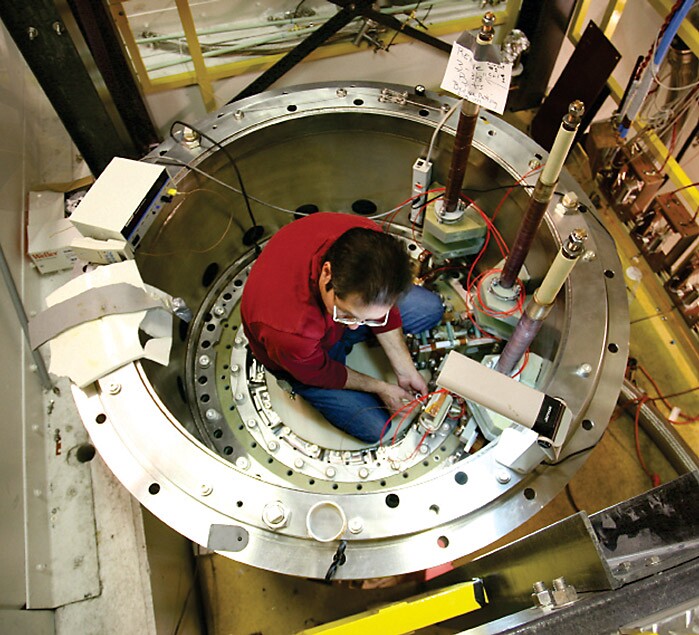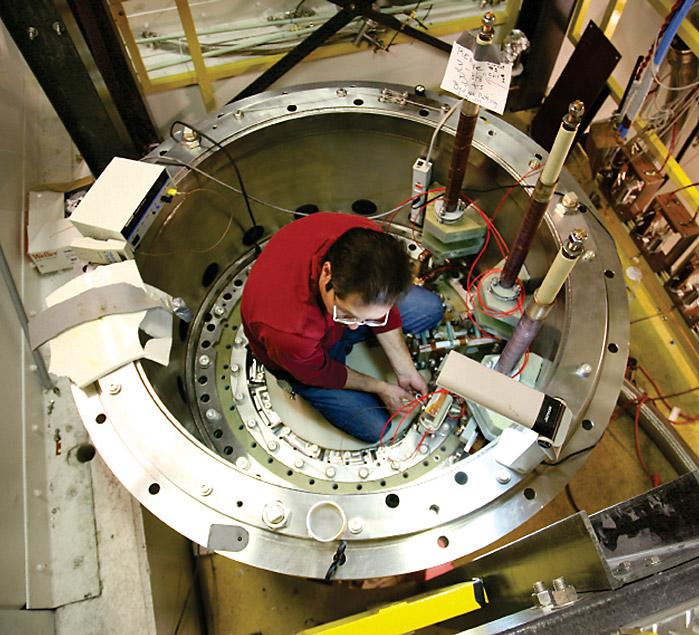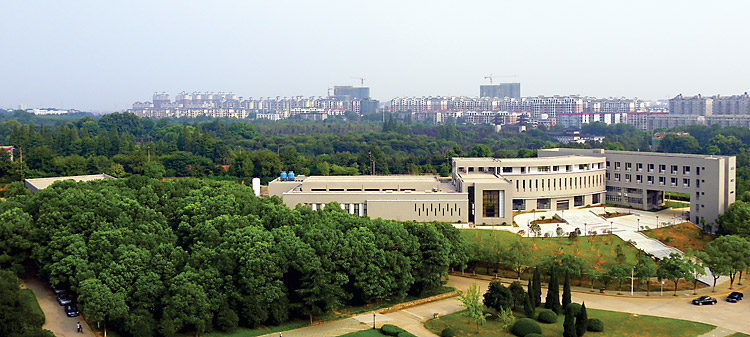Taking the pulse of magnet labs
DOI: 10.1063/PT.3.1326
Two magnet labs achieved new highs in pulsed-field strengths this past summer. In June the Dresden High Magnetic Field Laboratory (HLD) in Germany created a 91.4-tesla field. That was topped in August by the Los Alamos branch of the National High Magnetic Field Laboratory (NHMFL), with 97.4 T; in the coming months Los Alamos National Laboratory expects to boost the highest field it offers users from 85 T to 92 T.
“The first 100-T projects were advertised 20 years ago,” says Oliver Portugall, technical director of the National Pulsed Magnetic Field Laboratory in Toulouse, France. “But somehow nobody was capable of getting much beyond 70 T or 80 T until recently. A 5-T increase is quite significant. Higher fields open new horizons for fundamental research.”
At the Toulouse lab, the maximum field is 70 T, but “we are currently upgrading our installation in order to keep up with Dresden and Los Alamos,” says Portugall. His lab, he adds, “has the unique possibility to combine high magnetic fields with advanced photon and neutron sources.”
“In the 1980s I don’t think there was any pulsed-magnet user facility,” says NHMFL director Gregory Boebinger. The number of papers in Physical Review Letters that were based on work using pulsed magnetic fields started to grow in the 1980s and 1990s, he says. “Now, if you look at the most prestigious journals, the distribution of publications from research using DC and pulsed magnets is about even. That’s new in the last decade.” Among the advantages of pulsed-field magnets are that they can be much stronger than DC magnets and they are much cheaper to build and run.
Extreme conditions
When applied to materials, magnetic fields couple to both electron spins and electron orbital motions. Spin splitting of electron energy levels is proportional to the gyromagnetic ratio of the material and to the magnetic field; deviations provide information about electron–exchange interactions and internal magnetic fields. Orbital splitting, the formation of Landau levels due to the quantization of the electrons’ cyclotron motion, is inversely proportional to the effective mass of the material and proportional to the magnetic field. Landau levels can reveal the shape of the Fermi surface, the energy–momentum relationship for the highest-energy electrons in a metal.
“Applying a magnetic field gives you a knob to tune, and [it] sometimes tunes the strengths of interactions,” says Junichiro Kono, a physicist at Rice University who has worked at several of the big magnet labs. “It’s also a way to go to extreme conditions, where the electron kinetic energy is quenched due to magnetic confinement. It’s like freezing the motion of electrons. Unexpected things can happen in ultrahigh magnetic fields.” In his research, Kono applies high magnetic fields to low-dimensional systems such as nanotubes and graphene. High fields are also used to study the electronic properties of metals, semiconductors, superconductors, and other materials.
For high-temperature superconductors, says Suchitra Sebastian of the UK’s University of Cambridge, “the basic million-dollar questions are, Why are they superconducting? What is the glue that holds electrons together in Cooper pairs?” High magnetic fields are crucial to weaken superconductivity and reveal the underlying behavior of unpaired conducting electrons, she says. A strong applied magnetic field “is almost like a magnifying lens to help see the signal the electrons are tracing.” Higher fields also allow more of the doping phase diagram to be probed. Sebastian has used the 85-T magnet at Los Alamos to study underdoped yttrium barium copper oxide, and she looks forward to doing experiments at higher fields: “We really don’t know what we will see. Every time we go up, we get new information. And a lot of times we have had to change our thinking.”
Steady, spike, or bust
Pulsed fields are more difficult to work with than static ones. They typically have a duration of milliseconds, and the recovery time for a subsequent pulse is up to two hours, depending on the peak field strength. In recent years advances in electronics have broadened the scope of measurements possible with pulsed fields; for example, some nuclear magnetic resonance (NMR) experiments can now be done with the shorter-duration pulses. As a rule, heat capacity measurements, swept-angle measurements, and experiments that require a long acquisition time or a homogenous field, such as most NMR and electron spin resonance measurements, are best suited to static fields.
Even with their increasing popularity, pulsed magnets won’t put static ones out of business, says Boebinger. Currently the strongest static magnet is 45 T, at NHMFL’s site in Tallahassee, Florida. Scientists there are working on the conceptual design for a DC 60-T hybrid resistive-superconducting magnet. The price tag is “more than $50 million,” Boebinger says. For its full suite of eight DC magnets, the Tallahassee NHMFL site spends about $4 million annually on electricity.
By contrast, replacing one of Los Alamos’s 65-T workhorse pulsed magnets would cost about $60 000, estimates Boebinger. A new set of inner coils for the 85-T magnet comes to some $125 000; the coils have to be replaced roughly every 200 shots due to stress on materials. Energy costs for pulsed magnets are “negligible,” says HLD director Jochen Wosnitza. “A full charge of our capacitor bank costs about €2 [$2.70].” Pulses cost up to $1000 per shot, including “capital investment, energy, people’s time,” adds Toulouse’s Portugall.
A third magnet category produces destructive pulses. They are typically in the 100- to 1000-T range and last for microseconds. The pulse destroys the magnet and, above 300 T, the sample as well. One hot area of research using destructive magnetic fields is organic conductors, Portugall says. “They often have low mobility of electrons. At low-field ranges, we are not able to resolve [important effects]—they are washed out by scattering. So we may need 200 T or so.” But for most problems, the weaker, longer-lasting nondestructive fields are sufficient, he says. “Milliseconds is an eternity, and the electronic system will be in equilibrium during the pulse.”
Cranking up the field
Jacking up the field strength is mainly a matter of dropping the magnet bore diameter. Dresden reached its peak field by going from a 20-mm bore to a 16-mm one. And the 10-T jump to 97.4 T in Los Alamos’s multicoil magnet was made possible by reducing the bore from 15 mm to 10 mm. The other keys to raising the Los Alamos magnetic field strength were tweaking the winding of its inner magnet, improving the magnet’s structural reinforcement, and increasing the applied energy to crank the field in the experiment’s outer magnets from 37 T to 39 T, says magnet engineer Chuck Swenson. Nondestructive magnets, he says, are limited by “materials and the cleverness of engineering design.” Multicircuit magnets reduce heating and make it easier to evenly distribute stress over the magnet materials.
Having reached 97.4 T, says Boebinger, “our engineers are talking about 110 T. We are limited by funding.” The materials that go into the magnets are expensive, he says, giving as an example a nanocomposite of copper and niobium that costs roughly $475/kg. “We need to use the nanocomposites because of how strong the pressure of the field is on the materials—at 85 T it’s about 30 times the pressure at the bottom of the ocean. The pressure tries to explode the magnet materials.”
At Los Alamos, the outer magnets are driven by a $30 million power generator—a relic from a nuclear power plant that was first brought to the lab for a plasma fusion experiment—and the inner magnet uses a capacitor bank. The Dresden lab—which opened to users in 2007—sports the world’s largest capacitor bank. Each power method has its advantages and disadvantages, say the researchers. “The competition between the US and European labs has fostered the development of better magnets and improved measuring techniques,” says Wosnitza. “High-field science has experienced a boost during the last years.”
Higher fields, more labs
In addition to Los Alamos, Dresden, and Toulouse, the top pulsed magnet labs include the International MegaGauss Science Laboratory in Tokyo. That lab specializes in long pulses, up to 10 s in duration, and in destructive pulses up to 1000 T. The Japanese lab’s peak nondestructive field is 70 T, but like the other labs, it’s aiming for 100 T.
Quickly catching up with the more established pulsed-field labs is the Wuhan National High Magnetic Field Center in central China. It was founded in 2008 and is scheduled to open to users in 2013. The CNY180 million (roughly $28 million) Wuhan lab at Huazhong University of Science and Technology is the first major scientific facility in China to be under the auspices of a university rather than the Chinese Academy of Sciences. A sister lab in Hefei that focuses on static magnets is comparable to centers in Tallahassee; Tsukuba, Japan; Grenoble, France; and Nijmegen, the Netherlands.
Liang Li, the director of the Wuhan lab, earlier worked in Europe and the US and designed pulsed magnets at the NHMFL. So far, 7 of 11 planned experimental stations at Wuhan are ready; they are outfitted with low-temperature cryostats, lasers, and other instruments. Li says the Chinese lab has achieved 78.8 T and plans to test its first dual-stage magnet this month. “We will get as high as we can, hopefully to 85 T.”

This nondestructive magnet at Los Alamos National Laboratory last summer achieved a record pulse of 97.4 T. The lab plans to offer 92-T pulses to users soon.
Charles Mielke, LANL


China’s Wuhan National High Magnetic Field Center is the newest high-field pulsed magnet lab.
Yuan Cheng/Wuhan National High Magnetic Field Center


A single-turn coil before (left) and after (right) application of a 200-T, 6-microsecond pulse. At this field strength, the magnet is destroyed but the experimental sample survives; at higher field strengths both are destroyed.
(Courtesy of National High Magnetic Field Laboratory–Toulouse.)

More about the Authors
Toni Feder. tfeder@aip.org
